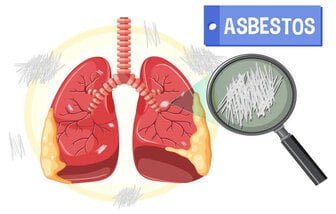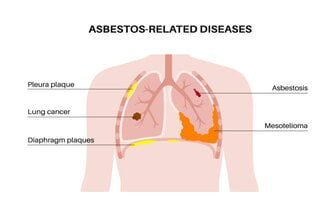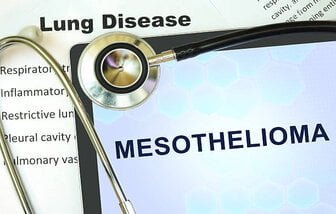Asbestosis Symptoms - All You Need To Know
Asbestosis is a chronic lung disease caused by prolonged exposure to asbestos fibers. This article covers the causes, symptoms, progression, diagnosis, and treatment options for asbestosis. It emphasises the importance of early detection, occupational safety, and preventive measures to minimise exposure and manage the disease effectively.
Understanding Asbestosis Symptoms: All You Need to Know
Asbestosis is a chronic lung disease primarily caused by prolonged exposure to asbestos fibers. Asbestos, once widely used in construction and various industries due to its fire-resistant properties, poses significant health risks when its fibers are inhaled.
These minuscule fibers, when lodged in the lung tissues, trigger an inflammatory response, leading to scarring and fibrosis.
The disease is categorised as a type of pneumoconiosis, which encompasses various lung conditions arising from inhaling different kinds of dust.
Asbestosis specifically results from asbestos exposure, and it is characterized by the gradual buildup of scar tissue in the lungs. This scarring hinders the lungs’ ability to expand and contract efficiently, ultimately impairing respiratory function.
Awareness and early detection of asbestosis are crucial. Many individuals who have worked in industries like construction, shipbuilding, and manufacturing may have been exposed to asbestos without realizing the potential long-term health consequences.
Symptoms of asbestosis may not manifest until many years after the initial exposure, making it imperative to recognize early warning signs and seek medical evaluation promptly.
Understanding the causes and progression of asbestosis can significantly aid in preventing further exposure and mitigating its impact. It is essential for individuals, especially those in high-risk occupations, to be informed about the dangers of asbestos and to adhere to safety guidelines to minimise exposure.
Early diagnosis can lead to better management of the disease and improve the quality of life for those affected.

Asbestosis is a chronic lung disease caused by inhaling asbestos fibers. Over time, these fibers can cause lung tissue scarring and long-term respiratory issues. Understanding how asbestosis develops is crucial for both prevention and early diagnosis.
Exposure to Asbestos
The development of asbestosis begins with exposure to asbestos. Asbestos is a group of naturally occurring minerals that are resistant to heat and corrosion. It was widely used in construction, insulation, and various industrial applications. When materials containing asbestos are disturbed, tiny fibers are released into the air. Inhaling these fibers can lead to significant health risks.
The Pathogenesis of Asbestosis
Once inhaled, asbestos fibers can become lodged in the lung tissues. The body’s immune response attempts to eliminate these fibers, but they are resistant to breakdown. Over time, this can lead to inflammation and scarring, known as fibrosis. The scarring thickens the lung tissues, making it difficult for oxygen to pass into the bloodstream. This gradual process of fibrosis is what characterizes asbestosis.
Symptoms and Diagnosis
Symptoms of asbestosis typically do not appear until many years after exposure. Common symptoms include shortness of breath, persistent cough, and chest pain. In severe cases, it can lead to respiratory failure. Diagnosis is usually confirmed through imaging tests, lung function tests, and a detailed occupational history.
Prevention and Management
Preventing asbestosis involves minimizing exposure to asbestos. This includes following safety regulations, using protective equipment, and ensuring proper handling and disposal of asbestos-containing materials. For those diagnosed with asbestosis, management focuses on alleviating symptoms and preventing further lung damage. This may include medications, pulmonary rehabilitation, and oxygen therapy.
Asbestosis is a chronic lung disease caused by inhaling asbestos fibers. These fibers can lodge in the lungs, leading to serious health complications over time. Early detection is crucial for managing the symptoms and improving the quality of life for those affected. This page outlines the early symptoms of asbestosis to help individuals recognize the signs and seek medical attention promptly.
Early Symptoms of Asbestosis
One of the initial indicators of asbestosis is shortness of breath, especially during physical activities. This occurs as asbestos fibers cause scarring in the lung tissues, reducing lung capacity. Another common early symptom is a persistent dry cough, which may be accompanied by chest pain. Fatigue and a general feeling of being unwell are also frequently reported by those in the early stages of the disease.
Importance of Early Detection
Recognizing the early symptoms of asbestosis is vital for timely intervention. Early detection can lead to better management strategies, preventing the progression of the disease. Regular health check-ups and consultations with healthcare professionals are recommended for individuals with a history of asbestos exposure. Early medical intervention can include measures to relieve symptoms, improve lung function, and enhance overall well-being.
Seeking Medical Advice
If you or someone you know is experiencing the early symptoms of asbestosis, it is essential to seek medical advice immediately. A healthcare professional can conduct necessary tests, such as chest X-rays and lung function tests, to diagnose the condition. Early and accurate diagnosis can significantly impact the treatment outcomes, providing a better quality of life for those affected by asbestosis.
In conclusion, understanding the early symptoms of asbestosis and seeking prompt medical attention can make a substantial difference in managing the disease. Stay informed and proactive about your health to mitigate the risks associated with asbestos exposure.
Asbestosis is a chronic lung disease caused by the inhalation of asbestos fibers. These fibers can cause significant damage to the lung tissue over time, leading to a range of progressive symptoms and complications. Understanding these symptoms and the potential complications is crucial for those at risk or currently dealing with the condition.
Early Symptoms of Asbestosis
The initial symptoms of asbestosis often include shortness of breath and a persistent dry cough. These symptoms can be subtle and may be mistaken for other respiratory conditions. As the disease progresses, these symptoms tend to become more pronounced and can significantly impact daily activities and quality of life.
Progressive Symptoms
As asbestosis advances, patients may experience more severe symptoms such as chest tightness, chest pain, and a loss of appetite leading to weight loss. Clubbing of the fingers and toes, where the fingertips become wider and rounder, is also a common sign of long-term oxygen deprivation caused by the disease. These progressive symptoms indicate that the lung damage is increasing, making it more difficult for the lungs to function properly.
Complications of Asbestosis
One of the most serious complications of asbestosis is the increased risk of lung cancer and mesothelioma, a type of cancer that affects the lining of the lungs. Additionally, patients may develop pulmonary hypertension, a condition where the blood pressure in the lungs’ arteries is higher than normal, leading to heart complications. Respiratory failure is another serious concern, as the lungs may eventually be unable to provide sufficient oxygen to the body.
Conclusion
Recognizing the progressive symptoms and potential complications of asbestosis is essential for early intervention and management. Regular medical check-ups and monitoring are crucial for individuals with a history of asbestos exposure. If you experience any of the symptoms mentioned, seeking medical advice promptly can help manage the condition and improve outcomes.
Asbestosis is a chronic lung condition caused by prolonged exposure to asbestos fibers. This condition leads to scarring of lung tissue, which can result in severe respiratory issues. Understanding how asbestosis is diagnosed is crucial for those who have been exposed to asbestos in their environment or workplace.
Symptoms and Initial Assessment
The diagnosis of asbestosis begins with recognizing its common symptoms. These may include shortness of breath, persistent cough, and chest pain. If you experience these symptoms and have a history of asbestos exposure, it is important to seek medical attention. The initial assessment usually involves a detailed medical history and a physical examination to identify any abnormal lung sounds.
Diagnostic Tests for Asbestosis
To confirm a diagnosis of asbestosis, several diagnostic tests may be conducted. A chest X-ray is often the first imaging test used, as it can reveal lung scarring and other abnormalities. In some cases, a high-resolution computed tomography (HRCT) scan is performed for a more detailed view of the lungs. Pulmonary function tests are also crucial, as they measure the lungs’ ability to move air in and out, indicating the severity of the lung impairment.
Additional Considerations and Follow-Up
After the initial diagnosis, it is essential to monitor the progression of asbestosis. Regular follow-up appointments with a pulmonologist can help manage the condition and address any complications. Additionally, patients should avoid further exposure to asbestos and may benefit from pulmonary rehabilitation programs to improve their quality of life.
Asbestosis is a chronic lung condition caused by prolonged exposure to asbestos fibers. These fibers can lead to lung tissue scarring, resulting in breathing difficulties and other serious health complications. Recognizing the symptoms early and seeking medical advice is crucial for managing the disease effectively.
Medications
While there is no cure for asbestosis, certain medications can help manage the symptoms. Doctors often prescribe bronchodilators to relax and open the air passages in the lungs, making breathing easier. In cases of severe inflammation, corticosteroids may be administered to reduce swelling and discomfort.
Oxygen Therapy
For patients experiencing significant difficulty in breathing, oxygen therapy can be a viable option. This treatment involves providing supplemental oxygen, either through a mask or nasal prongs, to ensure the body receives enough oxygen. This can help alleviate shortness of breath and improve the overall quality of life.
Lifestyle Changes
Adopting specific lifestyle changes can also play a significant role in managing asbestosis. Patients are advised to quit smoking, as it can exacerbate lung damage and increase the risk of further complications. Regular exercise, under medical supervision, can help maintain lung function and overall health.
Regular Monitoring
Frequent medical check-ups are essential for individuals diagnosed with asbestosis. Regular monitoring allows healthcare providers to track the progression of the disease and adjust treatment plans as needed. This proactive approach can significantly improve outcomes and help manage symptoms more effectively.
Managing Symptoms and Treatment Options
Asbestosis, a chronic lung condition caused by asbestos exposure, presents a range of symptoms that can significantly impact quality of life. Common symptoms include shortness of breath, persistent cough, and chest pain. Effectively managing these symptoms is crucial for patients seeking to maintain daily functionality and overall well-being.
Medically, several treatment options are available to alleviate the symptoms of asbestosis. Bronchodilators can help relax the muscles around the airways, making breathing easier. Steroids, on the other hand, reduce inflammation in the lungs, thereby easing symptoms like coughing and chest pain. For patients with more severe breathing difficulties, oxygen therapy can be a critical component of treatment. This involves the use of supplemental oxygen to ensure the body receives adequate levels of oxygen, which can alleviate fatigue and improve overall respiratory function.
Pulmonary rehabilitation programs are another valuable resource for individuals living with asbestosis. These comprehensive programs combine exercise training, nutritional advice, and education to help patients improve their lung function and maintain a better quality of life. Regular medical check-ups are essential to monitor the progression of the disease and adjust treatment plans as needed.
In addition to medical treatments, lifestyle changes play a vital role in managing asbestosis symptoms. Quitting smoking is paramount, as smoking can exacerbate lung damage and accelerate the progression of the disease. Maintaining a healthy diet rich in fruits, vegetables, and lean proteins supports overall health and can improve energy levels. Engaging in appropriate exercise, such as gentle aerobic activities, can enhance lung capacity and stamina.
Living with asbestosis requires a multifaceted approach to treatment and symptom management. By combining medical interventions with lifestyle modifications, individuals can better navigate the challenges posed by this chronic condition, ultimately improving their quality of life.
Adapting Your Lifestyle: Tips for Daily Living
Living with asbestosis presents unique challenges that necessitate thoughtful adjustments to daily routines. One of the primary strategies for managing asbestosis effectively is energy conservation. This involves planning and prioritizing activities to avoid unnecessary exertion. Simple measures such as breaking tasks into smaller steps, taking frequent rest breaks, and using assistive devices can significantly reduce fatigue and make daily tasks more manageable.
Modifying your home environment is another crucial step in managing asbestosis. Reducing exposure to irritants like dust, smoke, and strong scents can help minimize respiratory distress. Consider installing air purifiers, using hypoallergenic bedding, and ensuring proper ventilation in your living spaces. Regular cleaning and maintenance of heating and cooling systems can also contribute to a healthier indoor environment.
Another key aspect of living with asbestosis is pacing activities. Listen to your body and avoid pushing yourself beyond your limits. Activities should be interspersed with periods of rest to prevent overexertion. This approach not only helps in conserving energy but also in maintaining a better quality of life.
Emotional and mental health are equally important when dealing with a chronic condition like asbestosis. Joining support groups can provide a sense of community and shared understanding, offering emotional support and practical advice from others who are navigating similar challenges. Seeking counseling or therapy can also be beneficial in managing anxiety, depression, or other mental health concerns. Staying connected with friends and family is vital; their support can provide comfort and encouragement during difficult times.
Lastly, planning for the future is an essential consideration for individuals with asbestosis. This includes understanding your legal rights and exploring financial support options. Consulting with legal and financial advisors can help you make informed decisions about disability benefits, healthcare costs, and other financial matters.
By integrating these strategies into daily life, individuals with asbestosis can better manage their condition and maintain a more balanced, fulfilling lifestyle.
Support Systems and Resources
Living with asbestosis can be challenging, but numerous support systems and resources are available to help individuals manage this chronic condition. Patient advocacy groups play a crucial role in offering emotional support and practical advice. Organizations such as the Asbestos Disease Awareness Organization (ADAO) and the Mesothelioma Applied Research Foundation provide valuable resources, including patient education, advocacy, and community support.
Online forums and social media groups can also be beneficial. Platforms like Inspire and Facebook host communities where individuals with asbestosis can share their experiences, ask questions, and offer support to one another. These online spaces foster a sense of belonging and provide a wealth of shared knowledge.
Local support networks are another vital resource. Many communities have support groups facilitated by hospitals, clinics, or non-profit organizations, where patients can meet face-to-face to discuss their challenges and successes. These local groups often provide a more personal touch and can be instrumental in building long-term support relationships.
Legal assistance is an essential resource for those who have developed asbestosis due to occupational exposure. Law firms specializing in asbestos litigation can help patients understand their rights and pursue compensation. It’s crucial to seek legal advice promptly, as there are often time limits for filing claims. Resources like the Environmental Working Group or the American Bar Association can guide finding reputable legal help.
Educational resources are indispensable for patients and their families. Websites such as the American Lung Association and the National Heart, Lung, and Blood Institute offer comprehensive information on asbestosis, including symptoms, treatments, and ongoing research. Staying informed about the latest medical advancements can empower patients to make informed decisions about their care.
Effective communication with healthcare providers is vital for managing asbestosis. Patients should prepare for appointments by writing down their symptoms, questions, and concerns. Maintaining an open dialogue with doctors and specialists ensures that all aspects of the condition are addressed, leading to more comprehensive and personalized care.
Asbestosis Symptoms
Asbestosis is a chronic lung disease primarily caused by prolonged exposure to asbestos fibers. Asbestos, once widely used in construction and various industries due to its fire-resistant properties, poses significant health risks when its fibers are inhaled.
Asbestos-Related Diseases
Learn about asbestos, its industrial uses, and the serious health risks associated with exposure. Discover how to identify asbestos-containing materials, conduct surveys, and implement safety measures to prevent exposure.
Asbestos Lung Cancer
Once inhaled, asbestos fibers can lodge in the lung tissues, leading to inflammation and scarring over time. This can culminate in serious health issues, the most severe of which include asbestosis, mesothelioma, and asbestos lung cancer.
Asbestos Inhalation
Asbestos is a hazardous mineral known for its durability and heat resistance, historically used in various industries. Inhalation of asbestos fibers can lead to severe health issues such as asbestosis, lung cancer, and mesothelioma.
What is Mesothelioma
The most common sites for this malignancy are the pleura (lining of the lungs), peritoneum (lining of the abdomen), and pericardium (lining of the heart). Due to its aggressive nature, mesothelioma poses significant challenges in diagnosis and treatment
Asbestos Compensation
Learn about the dangers of asbestos exposure, the legal framework for seeking compensation, and the types of claims available for asbestos-related illnesses like mesothelioma and asbestosis. Discover how to navigate the claims process
Asbestos & Your Health
Learn about asbestos, a fibrous mineral widely used in construction until it was banned in the UK in 1999 due to significant health risks. Discover the serious conditions such as asbestosis, lung cancer, and mesothelioma caused by asbestos exposure.
Let's Work Together
Please complete the form below and someone from the Total team will be in touch to discuss your asbestos requirements For urgent needs, our customer support team is available through various channels. You can reach us via phone during business hours, or through our dedicated email support. We are committed to providing timely assistance and ensuring your asbestos concerns are addressed promptly and professionally.







